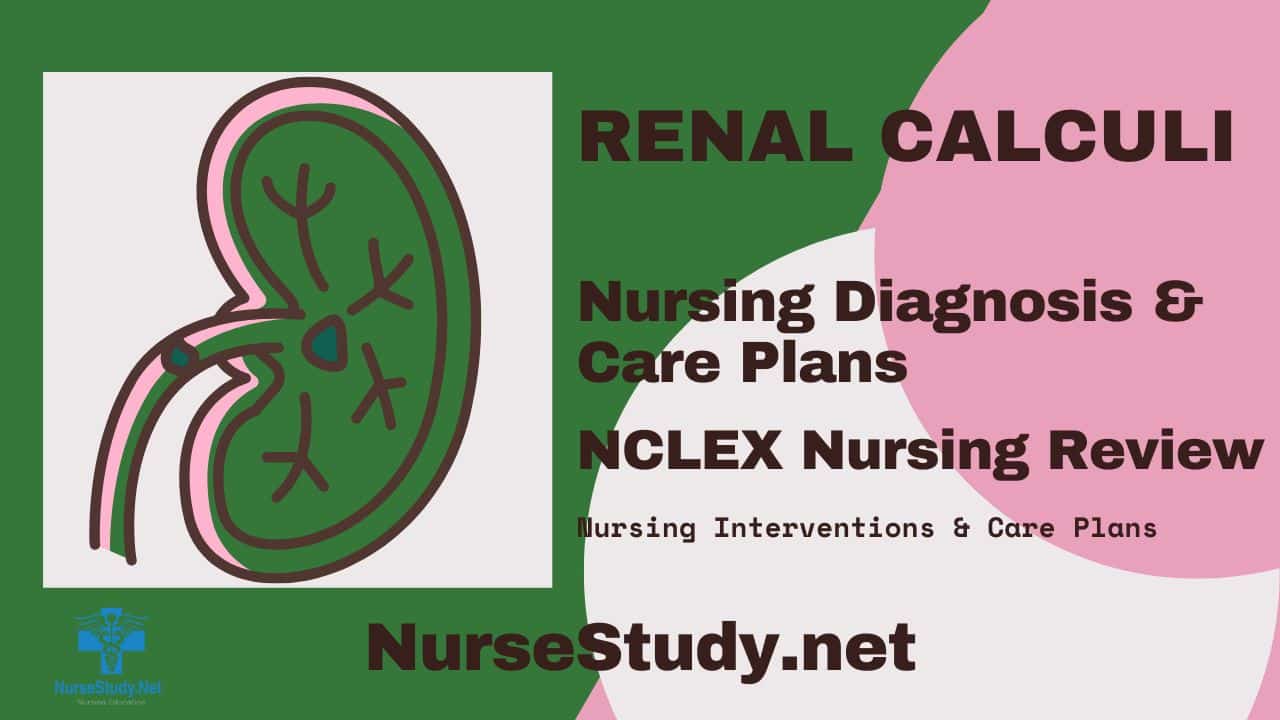Kidney stones (nephrolithiasis) present a significant challenge in nursing care, requiring comprehensive assessment and intervention strategies. This guide provides detailed nursing diagnoses, care plans, and evidence-based interventions for managing patients with kidney stones.
Understanding Kidney Stones
Kidney stones are hard deposits formed from minerals and salts within the kidneys. Common types include:
- Calcium oxalate stones (most common)
- Struvite stones (associated with UTIs)
- Uric acid stones
- Cystine stones
Nursing Assessment
Subjective Assessment
Pain Characteristics
- Severe flank pain radiating to the lower abdomen
- Sharp, colicky pain
- Pain that occurs in waves
- Dysuria
Associated Symptoms
- Nausea and vomiting
- Urinary frequency
- Urgency
- Hematuria
Objective Assessment
Physical Examination
- Vital signs monitoring
- Abdominal assessment
- Costovertebral angle tenderness
- Signs of dehydration
Diagnostic Tests
- Urinalysis
- Complete blood count
- Metabolic panel
- Imaging studies (CT scan, ultrasound)
Nursing Care Plans
1. Acute Pain
Nursing Diagnosis Statement:
Acute pain related to urinary tract obstruction by renal calculi as evidenced by verbal reports of pain, guarding behavior, and facial grimacing.
Related Factors:
- Tissue inflammation
- Ureter obstruction
- Muscle spasm
- Stone movement
Nursing Interventions and Rationales:
Assess pain characteristics
- Determines appropriate interventions
Administer prescribed medications
- Provides pain relief
Apply heat therapy
- Promotes muscle relaxation
Monitor pain relief effectiveness
- Ensures adequate pain management
Desired Outcomes:
- The patient reports decreased pain intensity
- Demonstrates improved comfort level
- Maintains normal vital signs
2. Risk for Infection
Nursing Diagnosis Statement:
Risk for infection related to urinary stasis and tissue trauma secondary to kidney stones.
Related Factors:
- Urinary obstruction
- Invasive procedures
- Tissue damage
- Stasis of urine
Nursing Interventions and Rationales:
Monitor vital signs
- Early detection of infection
Observe urine characteristics
- Identifies signs of infection
Maintain sterile technique
- Prevents contamination
Administer antibiotics as prescribed
- Treats/prevents infection
Desired Outcomes:
- Patient remains infection-free
- Maintains normal temperature
- Shows clear urine output
3. Deficient Fluid Volume
Nursing Diagnosis Statement:
Deficient fluid volume related to decreased oral intake and increased urinary losses as evidenced by concentrated urine and decreased urine output.
Related Factors:
- Nausea/vomiting
- Poor fluid intake
- Increased fluid losses
- Pain affecting intake
Nursing Interventions and Rationales:
Monitor fluid balance
- Ensures adequate hydration
Encourage oral fluids
- Promotes stone passage
Track intake/output
- Assesses fluid status
Assess hydration status
- Identifies deficits
Desired Outcomes:
- Maintains adequate hydration
- Shows improved urine output
- Demonstrates clear urine
4. Knowledge Deficit
Nursing Diagnosis Statement:
Knowledge deficit related to unfamiliarity with kidney stone prevention as evidenced by questions and verbalization of concerns.
Related Factors:
- Lack of exposure
- Misinterpretation
- Limited resources
- Complex information
Nursing Interventions and Rationales:
Assess knowledge level
- Identifies learning needs
Provide dietary education
- Prevents recurrence
Teach prevention strategies
- Promotes self-management
Review medication effects
- Ensures understanding
Desired Outcomes:
- Verbalizes understanding
- Demonstrates preventive measures
- Identifies risk factors
5. Impaired Urinary Elimination
Nursing Diagnosis Statement:
Impaired urinary elimination related to urinary tract obstruction as evidenced by frequency, urgency, and dysuria.
Related Factors:
- Stone obstruction
- Bladder irritation
- Ureter spasm
- Tissue inflammation
Nursing Interventions and Rationales:
Monitor urination patterns
- Assesses elimination
Strain urine
- Collects passed stones
Promote mobility
- Facilitates stone passage
Document characteristics
- Tracks progress
Desired Outcomes:
- Maintains normal elimination
- Reports decreased symptoms
- Passes stones successfully
Prevention and Education
Provide comprehensive patient education on:
- Dietary modifications
- Fluid intake requirements
- Medication compliance
- Warning signs
- Follow-up care
References
- Ackley, B. J., Ladwig, G. B., Makic, M. B., Martinez-Kratz, M. R., & Zanotti, M. (2023). Nursing diagnoses handbook: An evidence-based guide to planning care. St. Louis, MO: Elsevier.
- Bc, J. B. D. A., Rosenthal, L., & Yeager, J. J. (2021). Study Guide for Lehne’s Pharmacology for Nursing Care. Saunders.
- Harding, M. M., Kwong, J., & Hagler, D. (2022). Lewis’s Medical-Surgical Nursing: Assessment and Management of Clinical Problems, Single Volume. Elsevier.
- Herdman, T. H., Kamitsuru, S., & Lopes, C. (2024). NANDA International Nursing Diagnoses – Definitions and Classification, 2024-2026.
- Ignatavicius, D. D., Rebar, C., & Heimgartner, N. M. (2023). Medical-Surgical Nursing: Concepts for Clinical Judgment and Collaborative Care. Elsevier.
- eslie SW, Sajjad H, Murphy PB. Renal Calculi, Nephrolithiasis. [Updated 2024 Apr 20]. In: StatPearls [Internet]. Treasure Island (FL): StatPearls Publishing; 2024 Jan-. Available from: https://www.ncbi.nlm.nih.gov/books/NBK442014/
- Peerapen P, Thongboonkerd V. Kidney Stone Prevention. Adv Nutr. 2023 May;14(3):555-569. doi: 10.1016/j.advnut.2023.03.002. Epub 2023 Mar 9. PMID: 36906146; PMCID: PMC10201681.
- Prochaska ML, Taylor EN, Curhan GC. Insights Into Nephrolithiasis From the Nurses’ Health Studies. Am J Public Health. 2016 Sep;106(9):1638-43. doi: 10.2105/AJPH.2016.303319. Epub 2016 Jul 26. PMID: 27459448; PMCID: PMC4981801.
- Silvestri, L. A. (2023). Saunders comprehensive review for the NCLEX-RN examination. St. Louis, MO: Elsevier.
